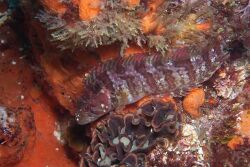Biology:Clinus berrisfordi
| Onrust klipvis | |
|---|---|

| |
| Scientific classification | |
| Domain: | Eukaryota |
| Kingdom: | Animalia |
| Phylum: | Chordata |
| Class: | Actinopterygii |
| Order: | Blenniiformes |
| Family: | Clinidae |
| Genus: | Clinus |
| Species: | C. berrisfordi
|
| Binomial name | |
| Clinus berrisfordi M. L. Penrith, 1967
| |
Clinus berrisfordi, the Onrust klipfish, is a species of clinid that occurs in subtropical waters of the Atlantic Ocean from False Bay to Skoenmakerskop, South Africa where it prefers marine and brackish habitats with plentiful growth of seaweed. This species can reach a maximum length of 12 centimetres (4.7 in) TL.[2]
Description
The body is slightly compressed. The snout is wedge-shaped, with an acute profile angle and moderate to thin lips. There are prominent tentacles above the eyes, with flattened stalks ending in several long filaments. The cirri on the front nostrils have a narrow stalk and a flattened, bilobed tip. The first three dorsal spines are not elevated to form a crest, but are equal to or longer than the fourth and succeeding spines, and there is no notch in the membrane between the third and fourth spines. The dorsal spines are tipped with clusters of 3 fine cirri for about half the length of the fin. The inner pelvic ray is always very small. The caudal peduncle is short.[3][4]
The body is reddish orange with about seven faint darker bars. Two dark lines radiate from the eyes across the cheek, and there is a dark ocellate spot on the shoulder. The fins are also reddish orange, faintly mottled and barred.[3][4][5]
Attains 12 cm.[5]
Diagnostics
The dorsal fin has 33 to 36 spines, followed by 5 to 6 rays. The anal fin has 2 spines and 22 to 25 rays. The pectoral fin has 11 to 13 rays, and the ventral fin has 1 spine and 3 rays. There are 3 to 4 gill rakers on the upper limb of the first gill arch ) and 6 to 7 on the lower limb. There are 16 to 17 abdominal vertebrae and 28 to 31 caudal vertebrae. The lateral line has about 23 vertically paired pores at the front and a few single pores above and below the line. There are 4.5 to 5 times the body depth in the standard length, and 3.4 to 4 times the head length in the standard length. The head length is from 3 to 4.2 times the eye diameter. The length of the caudal peduncle is 20% to 35% of the head length, and its depth is 20% to 35% of the head length head length.[3]
Common names
Onrust klipfish.[6]
Etymology
Berrisfordi: after C.D. Berrisford, who aided in collection of specimens.[6]
Distribution and habitat
Known from False Bay to just west of Algoa Bay.[5] Inhabits weedy pools at the bottom of the intertidal region.[4]
Reproduction
Viviparous.[7]
References
- ↑ Holleman, W.; Clements, K.D.; Williams, J.T. (2014). "Clinus berrisfordi". IUCN Red List of Threatened Species 2014: e.T178971A1554001. doi:10.2305/IUCN.UK.2014-3.RLTS.T178971A1554001.en. https://www.iucnredlist.org/species/178971/1554001. Retrieved 20 November 2021.
- ↑ Froese, Rainer and Pauly, Daniel, eds. (2013). "Clinus berrisfordi" in FishBase. April 2013 version.
- ↑ 3.0 3.1 3.2 Penrith, M.L., 1967. Studies on the South African Clinidae. II. Two new Species of Clinus from the Western Cape. Annals of the South African Museum 50(4): 43 – 59.
- ↑ 4.0 4.1 4.2 Penrith. M.L., 1969. The Systematics of the Fishes of the Family Clinidae in South Africa. Annals of the South African Museum 55(1): 1 – 121
- ↑ 5.0 5.1 5.2 Smith, M.M. & Heemstra, P.C., editors. 1986. Smith's Sea Fishes. Southern Book Publishers. 1047pp.
- ↑ 6.0 6.1 Zsilavecz, Guido, 2005. Coastal fishes of the Cape Peninsula and False Bay: A divers' identification guide. SURG, Cape Town. ISBN:0-620-34230-7
- ↑ Heemstra, P, and Heemstra, E., 2004. Coastal Fishes of Southern Africa, NISC/SAIAB, Grahamstown, ISBN:1-920033-01-7
Wikidata ☰ Q2238470 entry
 |


